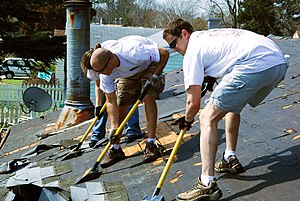Do It Yourself, Safely: Roofing
MySafetySign applauds the do-it-yourself spirit of home renovations, but there are often the same hazards in your weekend fixer-upper as there are on professional construction jobs. We want to make sure your project ends with a satisfied feeling of accomplishment, not a visit to the emergency room. Follow along as we cover the basics of home DIY in this new series: Do It Yourself, Safely.
While most of us have a healthy respect, if not fear, for heights, tackling your own roof repair can be a tempting proposition, particularly if it’s an emergency or if you’ve been quoted a hefty price by a professional roofer. But even if your house is one-story and has a flat roof, this DIY project has the potential for immediate and long-term hazards. Here are a few safety issues to consider when weighing the costs of a contractor versus the risks of DIY.
What can go wrong?
Falling from the ladder: The danger of a DIY roofing project begins before you even make it to the rooftop. According to the National Safety Council (NSC), ladders are one of the most common locations for falls in and around the home.
Falling off the roof: Also on the NSC’s list of top locations for falls around the home is “unguarded heights.” Even a fall from a single-level home can lead to broken and fractured bones, muscle sprains, torn ligaments, strains, concussions and death.
Falling objects: Roofing projects also pose ground-level risks, as unsecured materials and tools can slide off the roof and cause serious injury to anyone standing nearby. There have even been incidents in which people were injured while trying to clear ice dams from the roof. An elderly man was pinned by a 100-pound piece of ice when it finally gave way.
Faulty fixes: Improperly executed DIY fixes can lead to problems that a DIYer might not detect. If a leak is not properly fixed, for example, it can cause secondary problems such as mold and electrical damage.
Asbestos exposure: According to the Mesothelioma Cancer Alliance, asbestos was once used in all varieties of shingles, concrete mixtures and fiberboard, and still exists in nearly 80 percent of structures built prior to 1980. Removing damaged materials can be hazardous because the fibers can become airborne, leading to exposure that has been connected to the development of malignant mesothelioma.
Best practices
What to avoid:
- Wet roofs: Don’t go up on a roof if it’s wet – that includes a little morning dew.
- Slate, wood shake or clay tile installation or repair: These materials require special skills and tools to be properly installed.
- Ice dam removal: Working on a ladder resting against an icy gutter spells disaster. Call a professional.
- Extensive repairs: Long-term water damage can cause electrical problems, mold and structural instability, and damaged materials in older homes pose the risk of asbestos exposure.

Ice dams can cause serious damage to a roof, but removing them is not a DIY project. (Photo credit: Wikipedia)
Ladder safety:
- For every 4 feet of ladder height, place straight or extension ladders 1 foot away from the surface it rests against.
- Use a gutter guard or tie down the ladder to keep it secure.
- Place tools in a tool belt – don’t carry them in one hand while climbing up or down the ladder.
Rooftop safety:
- Wear rubber-soled shoes with a good tread to minimize the potential for slipping.
- Consider wearing a safety harness that is securely fastened to a tie off. According to Occupational Safety and Health Association (OSHA) regulations, when fall distances are over 6 feet or when a sloped roof has a rise steeper than 4 vertical feet for every 12 horizontal feet, roofing professionals must use precautions including a safety net, guardrail or “personal fall arrest system.”
- Clean the roof surface before you begin work, to avoid debris that can cause you to trip.
- Consider wearing knee pads to protect your knees from rough surfaces and old nails.
Ground-level safety:
Follow OSHA’s recommendations for the workplace: “During roofing work, materials and equipment shall not be stored within 6 feet of a roof edge unless guardrails are erected at the edge, and materials piled, grouped, or stacked near a roof edge must be stable and self-supporting.”
Resources
- Up on the roof: Those darn ice dams [Consumer Reports]
- The dangers of slips, trips and falls [National Safety Council]
- Asbestos in the Home [Mesothelioma Cancer Alliance]
Category: DIY Safety












